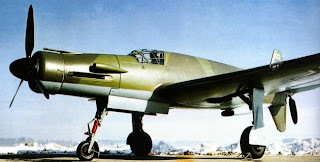We start today our list of the strangest aircrafts in history and we do
it with de Dornier DO 335 “Pfeil” which is our number 10. This aircraft whose
prototype flew for the first time in September, 1943 and was never produced in
series, was a tricky approach of Dornier to the design of a two-engine aircraft
with the characteristics of a single engine. With the tandem engine
configuration, the aerodynamic drag was considerably reduced and the asymmetry
problem in case of a single engine failure could be avoided, as it happens in
the multiengine aircrafts that have their engines under the wings.
The crux tail was designed to protect the lower rear propeller from
touching the ground during takeoff. With a maximum speed of 763 km/h at 6500 m
it was significantly over the allied fighters of the time and it was a very
promising craft. Even with a single engine it was able to reach 563 km/h, which
is exceptional for an aircraft with an empty weight of 5210 Kg.
Our position number10 of the strangest aircrafts of the history is for the DO335.
In this new entry of our blog we want to start a sweet talk speaking
about Donuts, a genuine American product like Coca Cola and in the same way as
this soft-drink, Donuts have spread over the years across the world becoming a
part our daily life.



